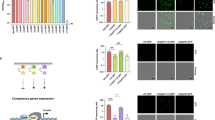Abstract
PREVIOUS studies have defined a specific element in Staphylococcus aureus containing determinants of inducible erythromycin resistance and spectinomycin resistance. This element has many plasmid-like properties1,2 but is not associated with detectable extra-chromosomal DNA2. The resistances are similar in mechanism to those ordinarily associated with plasmids3,4 (J. Davies, personal communication); the element can be transferred by transduction2 or transformation to a rec− recipient with the same efficiency as to a rec+, and the two determinants show essentially 100% linkage in genetic transfer. Consequently, this linkage group has previously been referred to as a ‘pseudoplasmid’ (ref. 2). On the basis of the results presented here, we suggest that this pseudoplasmid is actually the prototype of a new class of transposon, which functions by means of a highly efficient, represser-controlled, site-specific integration–excision mechanism. This transposon, designated Tn554 (EmSp), can be most easily envisaged as a prophage-like element that lacks replicative autonomy and other vegetative phage functions.
This is a preview of subscription content, access via your institution
Access options
Subscribe to this journal
Receive 51 print issues and online access
$199.00 per year
only $3.90 per issue
Buy this article
- Purchase on Springer Link
- Instant access to full article PDF
Prices may be subject to local taxes which are calculated during checkout
Similar content being viewed by others
References
Novick, R., Wyman, L., Bouanchaud, D. & Murphy, E. in Microbiology-1974 (ed. Schlessinger, D.) 115–129 (American Society for Microbiology, Washington, D.C., 1975).
Wyman, L., Goering, R. V. & Novick, R. P. Genetics 76, 681–702 (1974).
Lai, C. J. & Weisblum, B. Proc. natn. Acad. Sci. U.S.A. 68, 856–860 (1971).
Weisblum, B., Siddhikol, C., Lai, C. J. & Demohn, V. J. Bact. 106, 835–847 (1971).
Novick, R. P. J. gen. Microbiol. 33, 121–136 (1963).
Pattee, P. A. & Neveln, D. S. J. Bact. 124, 201–211 (1975).
Novick, R. P. et al. Plasmid 2, 109–129 (1979).
Pattee, P. A., Thompson, N. E., Haubrich, D. & Novick, R. P. Plasmid 1, 38–51 (1977).
Pattee, P. A. et al. Abstr. 78th A. Mtng Am. Soc. Microbiol. (1978).
Kleckner, N. Cell 11, 11–23 (1977).
Pattee, P. A., Kloos, W. E., Bodensteiner, J. B. & Zara, A. J. Virol. 2, 652–654 (1968).
Campbell, A. M. Adv. Genet. 11, 101–145 (1962).
Novick, R. P. Molec. gen. Genet. 135, 131–147 (1974).
MacHattie, L. A. & Jackowski, J. B. in DNA Insertion Elements, Plasmids, and Epitomes (eds Bukhari, A. I., Shapiro, J. A. & Adhya, S. L.) 219–228 (Cold Spring Harbor Laboratory, New York, 1977).
Author information
Authors and Affiliations
Rights and permissions
About this article
Cite this article
PHILLIPS, S., NOVICK, R. Tn554—a site-specific represser-controlled transposon in Staphylococcus aureus. Nature 278, 476–478 (1979). https://doi.org/10.1038/278476a0
Received:
Accepted:
Issue Date:
DOI: https://doi.org/10.1038/278476a0
This article is cited by
-
Transmission dynamics of a linear vanA-plasmid during a nosocomial multiclonal outbreak of vancomycin-resistant enterococci in a non-endemic area, Japan
Scientific Reports (2021)
-
Mobile genetic elements of Staphylococcus aureus
Cellular and Molecular Life Sciences (2010)
-
Understanding the rise of the superbug: investigation of the evolution and genomic variation of Staphylococcus aureus
Functional & Integrative Genomics (2006)
-
Nucleotide sequence of a spectinomycin adenyltransferase AAD(9) determinant from Staphylococcus aureus and its relationship to AAD(3″) (9)
Molecular and General Genetics MGG (1985)
-
Transposition of Tn554 does not generate a target duplication
Nature (1984)
Comments
By submitting a comment you agree to abide by our Terms and Community Guidelines. If you find something abusive or that does not comply with our terms or guidelines please flag it as inappropriate.



